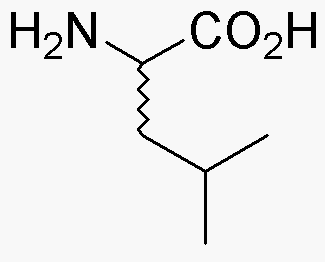DL-Leucine is widely utilized in research focused on:
- Sports Nutrition: Commonly found in protein supplements, it aids muscle recovery and growth, making it popular among athletes and fitness enthusiasts.
- Pharmaceuticals: Used in formulations to enhance the efficacy of certain medications, especially those targeting muscle degeneration and metabolic disorders.
- Animal Feed: Added to livestock diets to promote growth and improve feed efficiency, benefiting the agriculture industry.
- Cosmetics: Incorporated in skincare products for its moisturizing properties, helping to improve skin texture and hydration.
- Biotechnology: Serves as a building block in the synthesis of peptides and proteins in laboratory settings, facilitating various research applications.
General Information
Properties
Safety and Regulations
Applications
DL-Leucine is widely utilized in research focused on:
- Sports Nutrition: Commonly found in protein supplements, it aids muscle recovery and growth, making it popular among athletes and fitness enthusiasts.
- Pharmaceuticals: Used in formulations to enhance the efficacy of certain medications, especially those targeting muscle degeneration and metabolic disorders.
- Animal Feed: Added to livestock diets to promote growth and improve feed efficiency, benefiting the agriculture industry.
- Cosmetics: Incorporated in skincare products for its moisturizing properties, helping to improve skin texture and hydration.
- Biotechnology: Serves as a building block in the synthesis of peptides and proteins in laboratory settings, facilitating various research applications.
Documents
Safety Data Sheets (SDS)
The SDS provides comprehensive safety information on handling, storage, and disposal of the product.
Product Specification (PS)
The PS provides a comprehensive breakdown of the product’s properties, including chemical composition, physical state, purity, and storage requirements. It also details acceptable quality ranges and the product's intended applications.
Certificates of Analysis (COA)
Search for Certificates of Analysis (COA) by entering the products Lot Number. Lot and Batch Numbers can be found on a product’s label following the words ‘Lot’ or ‘Batch’.
*Catalog Number
*Lot Number
Certificates Of Origin (COO)
This COO confirms the country where the product was manufactured, and also details the materials and components used in it and whether it is derived from natural, synthetic, or other specific sources. This certificate may be required for customs, trade, and regulatory compliance.
*Catalog Number
*Lot Number
Safety Data Sheets (SDS)
The SDS provides comprehensive safety information on handling, storage, and disposal of the product.
DownloadProduct Specification (PS)
The PS provides a comprehensive breakdown of the product’s properties, including chemical composition, physical state, purity, and storage requirements. It also details acceptable quality ranges and the product's intended applications.
DownloadCertificates of Analysis (COA)
Search for Certificates of Analysis (COA) by entering the products Lot Number. Lot and Batch Numbers can be found on a product’s label following the words ‘Lot’ or ‘Batch’.
*Catalog Number
*Lot Number
Certificates Of Origin (COO)
This COO confirms the country where the product was manufactured, and also details the materials and components used in it and whether it is derived from natural, synthetic, or other specific sources. This certificate may be required for customs, trade, and regulatory compliance.


